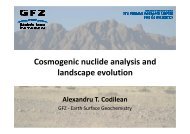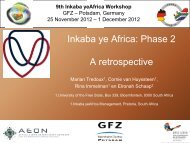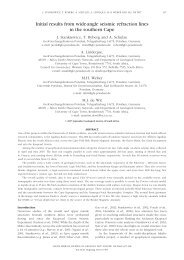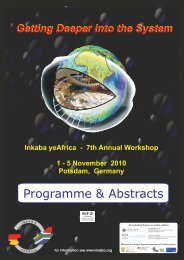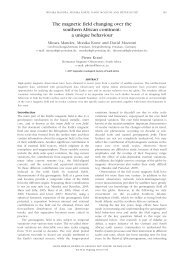South Africa - Inkaba.org
South Africa - Inkaba.org
South Africa - Inkaba.org
You also want an ePaper? Increase the reach of your titles
YUMPU automatically turns print PDFs into web optimized ePapers that Google loves.
Denudation rates and geomorphic evolution of the Cape<br />
Mountains determined through cosmogenic dating using<br />
10 Be and 21 Ne in quartz<br />
1 T.Scharf, 2 A. Codilean, 3 M.J de Wit, S. 4 Niedermann,<br />
1. AEON-University of Cape Town, <strong>South</strong> <strong>Africa</strong>, taryns1@gmail.com<br />
2. Earth Surface Geochemistry, GFZ, Potsdam, Germany, codilean@gfz-potsdam.de<br />
3. AEON-University of Cape Town, <strong>South</strong> <strong>Africa</strong>, maarten.dewit@uct.ac.za<br />
4. In<strong>org</strong>anic and Isotope Geochemistry, GFZ, Potsdam, Germany, nied@gfz-potsdam.de<br />
ABSTRACT<br />
The Cape Mountains, consisting of resistant quartzite, sandstones, as well as argillaceous material, form a<br />
distinctive high relief area in comparison to the adjacent Karoo region to the north. The river systems draining the<br />
southern ranges of the mountain system consist almost exclusively of short, near-linear rivers that have cut down<br />
into the resistant rocks of the mountain ranges, leaving behind incised meanders and abandoned river terraces<br />
within steep sided canyons.<br />
The origin and timing of this Cape landscape remains unresolved. Fission track data suggests that the region was<br />
largely exhumed in the Cretaceous, followed by possible further uplift in the Cenozoic. Whether this second-order<br />
uplift took place continuously as an isostatic phenomenon, or as isolated tectonic uplift events, is unknown.<br />
Previous cosmogenic data further inland of the Cape Mountains have yielded low recent erosion rates (



